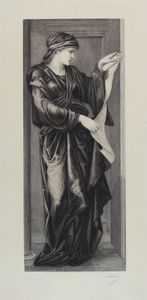| Method | Etching |
| Artist | Charles Albert Waltner after Sir Edward Coley Burne-Jones |
| Published | Published by Thos, Agnew & Sons. London, Liverpool and Manchester. November 1st. 1882. |
| Dimensions | Image 440 x 180 mm, Plate 515 x 230 mm, Sheet 620 x 378 mm |
| Notes |
Signed by artist and engraver. Bears PSA Stamp. The painting from which this etching was taken, 'The Cumaean Sibyl', is now in a Private Collection. In Burne-Jones' classically inspired image, the Cumaean Sibyl - a priestess who presided over the Apollonian oracle at Cumae, a Greek colony near Naples - stands in full-length, reading from a scroll. The niche-like setting resembles Renaissance frescoes, which were known to be a source of inspiration for Burne-Jones. Sir Edward Coley Burne-Jones, 1st Bt (1833-1898) was a painter and designer closely associated with the later phase of the Pre-Raphaelite movement. Burne-Jones met William Morris as an undergraduate of Exeter college, Oxford, whilst studying for a degree in theology. The pair went on to work very closely together on numerous decorative arts projects including stained glass windows, tapestries and illustrations. Originally intending to become a church minister, Burne-Jones never finished his degree, choosing instead to pursue an artistic career under the influence of Dante Gabriel Rossetti. Rossetti heavily inspired his early work, but by the 1860's his idiosyncratic style was beginning to develop. His mature work, however different in total effect, is rich in conscious echoes of Botticelli, Mantegna and other Italian masters of the Quattrocento. Thusly, Burne Jones' later paintings of classical and medieval subjects are some of the most iconic of the Pre-Raphaelite movement. He was at the height of his popularity during the 1880's, though his reputation began to decline with the onset of the Impressionists. He was created a baronet in 1894, when he formally hyphenated his name. Charles Albert Waltner (1846 - 1925) was one of the most prolific reproductive engravers of his time. Born in Paris, he studied art under Louis Pierre Henriquel-Dupont and Jean-Leon Gerome. In 1868 he was awarded a scholarship to Rome, and made his debut at the Paris Salon two years later. Mainly engraving for the Journal de Beaux Artes and L'Art, Waltner's work was popular in both France and Britain. An admirer of his expressive style, the British Pre-Raphaelite founder Sir John Everett Millais, actively sought Waltner to reproduce five of his compositions as etchings, including The Widow's Mite. In 1882 the French government appointed him a chevalier of the Legion d'honneur, and in 1900, he received the Grand Prize for his art from the Exposition Universelle. Condition: Tape residue to top sheet edge. Toning to margins. Framed in a period frame. |
| Framing | framed |
| Price | £3,500.00 |
| Stock ID | 50514 |

